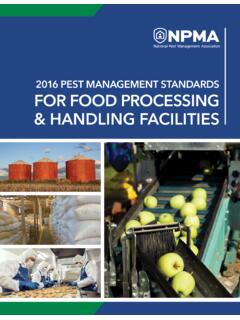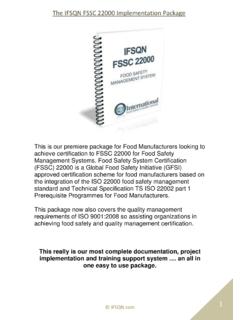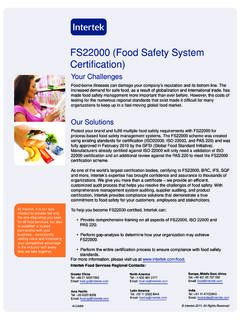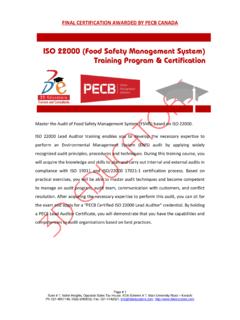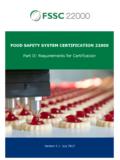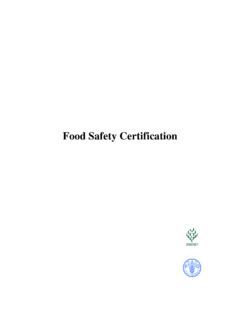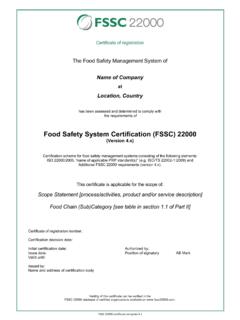Transcription of Food Safety Audit Scheme Quick Reference Guide January 2018
1 food Safety Audit Scheme Quick Reference Guide January 2018. FSSC 22000 - food NPMA - National M rieux AIB - American BRC Global NSF-Cook & SQF - Safe Quality Safety system Pest Management Primus GFS NutrSciences YUM Brands Institute of Baking Standards for food Thurber food Certification Association Certification LLC. Exterior Rodent Control Device Types Not specified. Not specified, bait Must be described in Based on history and Not Specified, Bait Bait stations or live traps. Bait stations must be Based on a risk Must be effectively stations shall be secured program. Detectors and assessment of potential stations must be Bait secured within secured in place next to assessment and resultant maintained, no loose or in place or placed/located traps shall be of robust, for infestation.
2 (Bait identified, locked and station. Bait stations building, closed, and a key validated pest granular rodenticide is in such a way as they tamper-resistant stations or multiple-catch secured in place . Secured should be secured with a or a tool ( allen management plan so that approved for use. Bait cannot be inadvertantly construction. They shall traps) means not easily removed ground rod, chain, cable wrench) is required to the proper device, stations shall be used or accidently moved be appropriate for the and/or are not removable or wire, or glued to the open. location and placement is outside the facility. during normal factory target pest by general public. wall/ground, or secured implemented.
3 Operations. with a patio stone (wall Verification should be signs are required if using used to ensure type is a patio stone) to prevent working for pest the bait from being prevention. removed by shaking, washed away, etc Tamper Resistant Bait stations must be Compliance with EPA PRN Determined by individual Compliance with EPA PRN Compliance with EPA PRN Bait stations should be Bait stations must be Not specified Not specified, but expected tamper resistant, 94-7 tier 1 bait station auditor and specific 94-7 tier 1 bait station 94-7 tier 1 bait station tamper resistant secured in place and positioned, anchored in sufficient. circumstances. sufficient. sufficient. through the use of tamper resistant.
4 Place, locked, and labeled. screws, latches, locks, or by other effective means. Device Spacing Placement of exterior Appropriately located Pest-monitoring programs Based on professional Must be made based 25 to 75 feet. 25-50 feet but based Described in facilities Devices are located in such rodent monitoring devices shall include the placing of judgment and history and upon habitat and upon risk document pest a manner as to not is based on the detailed detectors and traps in key assessment of potential potential access management plan. conatiminate product, facility survey and activity locations to identify pest for infestation. In the packaging materials or history as required by activity.
5 Absence of historical data, equipment. Must be placed county or local regulatory initial spacing of 50 to 100 to achieve maximum requirements. In absence feet. efficiency. of an assessment devices are placed in intervals of 50 to 100 feet. Doors Not specified Not specified External doors, windows Devices should be placed Must be made based Within 6 feet of both Not specified All external windows, Devices are located in such or ventilation openings on either side of doors upon habitat and sides of all entry doors, ventilation openings, a manner as to not shall be designed to that lead to the exterior potential access except public access doors and other openings contaminate product, minimize the potential for doors.
6 Shall be effectively sealed packaging materials or entry of pests. when close and proofed equipment. Must be placed against dust, insects and to achieve maximum other pests. efficiency. Service Frequency At Least monthly or more Determined by risk The detectors and traps Based on history and Weekly Monthly Monthly Described in facilities Minimum of monthly often if activity dictates. assessment shall be inspected at a assessment of potential document pest inspections, and more frequency intended to for infestation (monthly management plan. frequent as necessary identify new pest activity. minimum) depending on risk factors The results of inspections shall be analyzed to identify trends.
7 Interior Rodent Control food Safety Audit Scheme Quick Reference Guide January 2018. FSSC 22000 - food NPMA - National M rieux AIB - American BRC Global NSF-Cook & SQF - Safe Quality Safety system Pest Management Primus GFS NutrSciences YUM Brands Institute of Baking Standards for food Thurber food Certification Association Certification LLC. Device Types Toxic and non-toxic Located and maintained Must be described in Rodenticides shall not be Only mechanical traps or Multi-catch traps or glue Not specified. No bait to Based on a risk Must be effectively commercial baits are not to prevent contamination program. Detectors and used inside food plants, glue boards must be used boards in stations or PVC be used in the facility.
8 Assessment and resultant maintained, no loose or used for interior risk to product; Toxic traps shall be of robust, unless approved by plant inside the facility (interior pipes. Multi-catch traps validated pest granular rodenticide is monitoring. Mechanical rodent baits shall not be tamper-resistant and permitted by label. baiting is allowed in some may be supplemented management plan so that approved for use. Bait traps, extended trigger used within production or construction. They shall Interior multiple-catch countries outside of the with snap traps in stations the proper device, stations shall be used traps and glue boards. storage areas; Any missing be appropriate for the traps do not need to be United States).
9 In certain areas. Interior location and placement is outside the facility. Facilities in countries that bait stations shall be target pest anchored. Program shall traps locate with a wall implemented. Verification prohibit the use of recorded, reviewed and be adjusted according to sign stating trap number shall be used to ensure mechanical traps may investigated. Where toxic 12 month trends. as a trap identifier in case type is working for pest consider the use of baits are used these shall a trap is moved. prevention. alternatives. The Device be secured. should not go against the regulation. Device Spacing In the absence of an Appropriately located Pest-monitoring programs Based on history and Trap locations should be 20 to 40 feet around The spacing is at Described in facilities Devices are located in such assessment monitoring shall include the placing of assessment of potential recommended by the PCO interior perimeter of all consistent intervals document pest a manner as to not devices are placed at detectors and traps in key for infestation based on potential access walls.
10 Must have traps (typically 20-40ft., but management plan. contaminate product, intervals of 20 to 40 feet locations to identify pest (recommended devices and knowledge of pest inside coolers at cold based upon risk) around packaging materials or along exterior walls. activity. placed along exterior wall habits. storage and cooler the interior perimeter of equipment. Must be placed Based on the detailed inspection aisle, white operations. Cold rooms at the building area and to achieve maximum facility survey, interior paint 18 inches wide). In packing house and around interior perimeter efficiency. monitoring devices are the absence of historical processors recommended of any walled in dry food placed in sensitive areas data, initial spacing of 20 but left to auditor's storage, packaging or towards the interior of to 40 feet.

